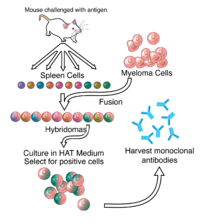
Photo from wikipedia
In our continuing effort to develop effective anti-heroin vaccines as potential medications for the treatment of opioid use disorder, herein we present the design and synthesis of the haptens: 1-AmidoMorHap… Click to show full abstract
In our continuing effort to develop effective anti-heroin vaccines as potential medications for the treatment of opioid use disorder, herein we present the design and synthesis of the haptens: 1-AmidoMorHap (1), 1-AmidoMorHap epimer (2), 1 Amido-DihydroMorHap (3), and 1 Amido-DihydroMorHap epimer (4). This is the first report of hydrolytically stable haptenic surrogates of heroin with the attachment site at the C1 position in the 4,5-epoxymorophinan nucleus. We prepared respective tetanus toxoid (TT)–hapten conjugates as heroin vaccine immunogens and evaluated their efficacy in vivo. We showed that all TT–hapten conjugates induced high antibody endpoint titers against the targets but only haptens 2 and 3 can induce protective effects against heroin in vivo. The epimeric analogues of these haptens, 1 and 4, failed to protect mice from the effects of heroin. We also showed that the in vivo efficacy is consistent with the results of the in vitro drug sequestration assay. Attachment of the linker at the C1 position induced antibodies with weak binding to the target drugs. Only TT-2 and TT-3 yielded antibodies that bound heroin and 6-acetyl morphine. None of the TT–hapten conjugates induced antibodies that cross-reacted with morphine, methadone, naloxone, or naltrexone, and only TT-3 interacted weakly with buprenorphine, and that subtle structural difference, especially at the C6 position, can vastly alter the specificity of the induced antibodies. This study is an important contribution in the field of vaccine development against small-molecule targets, providing proof that the chirality at C6 in these epoxymorphinans is a vital key to their effectiveness.
Journal Title: Molecules
Year Published: 2022
Link to full text (if available)
Share on Social Media: Sign Up to like & get
recommendations!